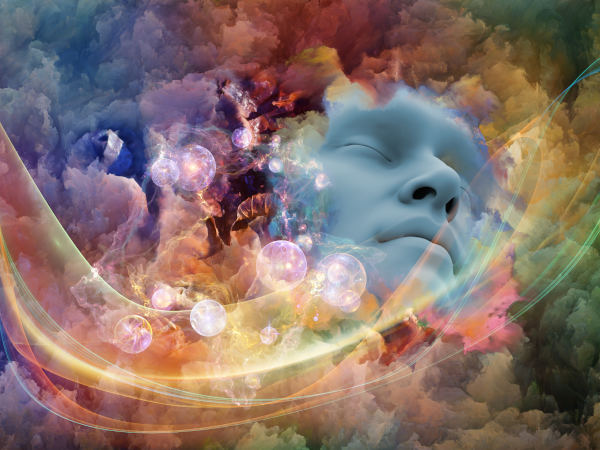Dreams are a common aspect of human experience and have existed since the dawn of humanity. People have been wondering what dreams mean for hundreds of years. Early civilizations regarded them as a conduit between people and the gods. The Greeks and Romans held the belief that dreams contained the ability to foretell the future.
However, as science progressed, several views on the meaning of dreams developed. Sigmund Freud, a renowned psychologist, regarded dreams as the “royal road” to the unconscious, claiming that by analyzing the evident content of dreams, we may reveal the hidden and unconscious desires that cause neuroses.
His hypothesis holds that dream interpretations that go deeper can help us realize our thoughts and emotions, which can be helpful in gaining personal insight.
Additionally, ideas and visuals might arise from our dreams. Artists and musicians seek inspiration from their dreams. Authors, screenwriters, and poets create stories based on their dreams. In addition, dreams can enable us to gain a fresh perspective on matters and discover solutions to our daily challenges.
As a result, studying dream symbols and assigning significance to them has become a popular form of entertainment as well as self-reflection. But do dreams actually represent anything? Can you discover your unconscious aspirations and desires by deciphering your dreams?
In this article, we’ll look at the science of dream interpretation, from early twentieth-century psychoanalysts to the most contemporary science-based ideas that investigate the fundamental meaning of dreams. Furthermore, we shall examine the most typical types of dreams.
Definition of Dreams
Dreams are a series of involuntary thoughts, visual experiences, and emotional responses that occur while sleeping. About six years of our lives are spent dreaming. Each night, the average individual dreams for around two hours 1, which is a normal aspect of restful sleep. In dreams, you can also hear sounds and feel physical sensations.
Their duration may vary from a few seconds to half an hour. Those who are able to recall their dreams have awakened from REM sleep. Your average nightly dream count is five to seven, and the more you sleep, the longer your dreams seem to be.
Dreams start in early childhood and grow in frequency and length until maturity. They seem to be activated when the brain’s typical activity shifts or decreases, as occurs while we sleep.
Dreams may create a complicated story that is highly personal. A lot of individuals are keen to discuss the details of their dreams and try to decipher their deeper significance. If you have repeated dreams about the same person or thing, they are a mirror of your hopes, fears, ambitions, and purpose.
When you have a pleasant dream, your subconscious is entertaining thoughts that you want to happen. On the other hand, during a nightmare, your mind is trained by visualizing bad things that could happen. However, it remains uncertain if particular dreams have a deeper meaning.

Historical Perspectives On Dream Interpretation
Since the beginning of time, people have been interested in dreams, which makes sense. We have been interested in and attempted to comprehend our dreams for as long as we have been able to discuss them.
Dream interpretation has been documented for at least three thousand years, dating back to the Sumerian culture in modern Iraq. Egyptian priests believed that dreams were a form of divine communication, whereas the Greeks considered them to be very important omens.
Dreams had a religious connotation during the Greek and Roman civilizations. They were thought to be direct messengers from the gods or the deceased. During that period, individuals looked to their dreams for guidance on what to do or how to act. They were convinced that dreams could tell them about the future.
In an effort to receive a message through dreams, special shrines have been erected where individuals can go to sleep. Their trust in the power of a dream was so great that it even influenced the acts of political and military leaders. Dream interpreters even escorted military commanders into combat to aid in the development of their war strategy.
A 2009 study by psychologists Carey Morewedge and Michael Norton2 revealed that the impact of this atavism is still present: it can cause people to cancel a trip more often when they dream about a plane crash than when they consciously consider it, when authorities warn of a terrorist threat, or when they hear about a crashed plane.

Aristotle, the Greek philosopher, thought that dreams were a byproduct of physiological processes. Dreams could forecast the development of illnesses and detect ailments.
During the Hellenistic period, the primary focus of dreams was on their potential to heal. Dreams’ healing power inspired the construction of temples known as Asclepieions. It was thought that ailing people who slept in these temples would get cures through their dreams. Dream interpreters even assisted medical professionals in their diagnoses. Dreams were thought to provide important clues for healers to determine what was wrong with the dreamer.
In Egypt, priests also served as dream interpreters. The Egyptians used hieroglyphics to record their dreams. People who had very vivid and profound dreams were thought to be blessed and exceptional. While dream interpreters were revered and considered to be endowed with divine abilities.
Zhuang Zhou, a philosopher, questioned himself in the third century BC in China: was he truly dreaming of being an insect, or was the butterfly dreaming of being Zhuang Zhou, when he woke up from his dream of being a butterfly?
The Chinese also thought that the soul leaves the body during sleep and enters the realm of dreams. However, if they are suddenly woken, their soul may not return to the body. As a result, some Chinese people nowadays are skeptical of alarm clocks.
People in some early societies couldn’t tell the difference between the dream world and the real world. They believed the dream world to be a more powerful realm in addition to being an extension of reality.
Several Mexican and Native American cultures share this idea of a distinct dream realm.
They had the belief that their forefathers took non-human forms, such as plants, and lived in their dreams. They consider dreams as a chance to visit and communicate with their ancestors. Dreams also helped them figure out what their life’s purpose was.
In the Middle Ages, dreams were associated with evil and their imagery with demonic seduction. The devil was considered to instill harmful thoughts in individuals’ minds while they were sleeping. Through dreams, he carried out his dirty work by trying to steer us in the wrong direction.
Dreams were regarded in the early nineteenth century as the result of worry, household noises, or even indigestion. As such, it truly had no significance. Later in the nineteenth century, Sigmund Freud reintroduced the value of dreams and the necessity for interpretation. He changed the way dreams were studied forever.
Related reading: Dreams Decoded: A Journey into Dream Interpretation – Opens in new tab
Theories of Dreaming
Dream analysis and the question of whether our dreams really mean something are very controversial topics. People have attempted to understand 3 the meaning of dreams since the birth of civilization, but the scientific study of dreams is relatively new.
In contemporary times, several schools of psychology and neuroscience have proposed hypotheses concerning the meaning and purpose of dreams. Pioneers4 from the early twentieth century and current neuroscientists 5 have contributed to the most recognized theories of dream interpretation.
Here, we will look at some of these theories from science.

Alfred Adler’s Theory
Alfred Adler (1870–1937) believes that there is a link between your dreams and your difficulties in real life. More dreams mean more troubles. On the other hand, if you experience fewer dreams, you are more psychologically healthy and have fewer problems.
In his opinion, dreams serve as a valuable instrument for gaining mastery over one’s waking existence. They are problem-solving tools. It is necessary to analyze and bring dreams to consciousness in order to have a deeper comprehension of your problems. It is crucial to take the lessons you gain from your dreams and apply them to your daily life.
According to Adler, dreams are a window into your inner thoughts, feelings, and deeds. Your violent instincts and desires can be vividly shown in your dreams. Dreams can also help you compensate for deficiencies in your waking life.
For instance, if you find it difficult to articulate your actual feelings in relationships, you may find that your dreams serve as a canvas for your unsaid feelings, enabling you to communicate more freely and honestly in the dream world. Dreams provide a more acceptable form of fulfillment.
“Never go to sleep without a request from your subconscious.” -Thomas Edison
Freudian Theory
The most quoted psychologist of the 20th century, Sigmund Freud (1856–1939), released “The Interpretation of Dreams” in 1900 (aff.link). This book was a key milestone in the area of dream analysis.
In his book, Sigmund Freud proposed that the content of dreams is linked to desire fulfillment 6.
Although he said that dreams are based on reality, they should not be interpreted literally because they differ from waking life. Rather, the deeper significance of a dream is concealed in the unconscious mind of the dreamer—in the ideas and emotions that exist outside of their cognitive consciousness.
According to Freud, the images and events that make up a dream’s apparent content are meant to mask the dreamer’s unconscious desires, or latent content. Basically, Freud thought that what you dream about shows what you want in life.
He also explained the four elements of this process, which Freud called “dream work.”
- Condensation: A single dream might reflect a wide range of thoughts and concepts. Condensed information is contained in a single thought or visual.
- Displacement: This aspect of dream work mixes up the crucial and unimportant aspects of the dream, masking the emotional significance of the hidden material.
- Symbolization: This process also hides the dream’s blocked ideas by adding things that are meant to represent the dream’s hidden meaning.
- Secondary revision: Freud proposed that during this last phase of dreaming, the strange components of the dream are rearranged to make the dream understandable, resulting in the creation of the manifest content of the dream.
Freud used a very simple way to figure out what dreams meant. Rather than interpreting his patients’ dreams for him, he encouraged them to speak about whatever came to mind with each dream feature, allowing their own thoughts to guide them.
He urged them to let go of their critical thinking skills and to stop suppressing ideas that were uncomfortable, unimportant, or absurd. The patient is permitted to speak in a continuously flowing stream of words. According to Freud, this non-linear mode of thinking would give rise to the unconscious mind.
He referred to this process as free association. Using the technique of free association, Freud concluded that dreams are the covered-up realization of suppressed childhood desires.
“I must affirm that dreams really have a meaning and that a scientific procedure for interpreting them is possible.” – Sigmund Freud

Jungian Theory
Carl Jung (1875-1960), a contemporary of Freud, was heavily influenced by his Interpretation of Dreams 7. However, as Jung developed, his views on dream interpretation started to diverge from those of Freud. He believed that dreams were more than just a reflection of suppressed desires.
According to Jung, there are several kinds of dreams that people could analyze using the concept of “compensation.” Dreams, according to his compensation theory, compensate for undeveloped aspects of the psyche in waking life.
Jung also proposed that archetypes like the anima, shadow, animus, and persona are frequently shown as symbolic objects or characters in dreams. 8
From his perspective, these symbols stood for attitudes that the conscious mind suppresses.
According to part of Jung’s theory, everything may be seen as paired opposites, such as male and female, good and evil, or love and hatred.
Thus, the “counterego,” or what he calls the shadow, operates in opposition to the ego. The shadow symbolizes the aspects of oneself that are shunned and do not desire to be acknowledged. The shadow is less sophisticated, awkward, and more primal.
In contrast to Freud, who frequently proposed that certain symbols stand for certain unconscious concepts, Jung considered that dreams may be very personal and that interpreting them required a deep understanding of the dreamer.
Calvin S. Hall’s Theory
Psychologist Calvin S. Hall (1909–1985) proposed in the 1950s that dreams were visuals that represented a person’s thoughts or ideas. According to Hall, dreams are like dramas or enactments that are based on an individual’s beliefs about themselves, other people, conflicts, drives and impulses, and their surrounding environment.
Hall proposed that interpreting dreams might provide insight into a person’s psyche and influence their actions in the physical world.
Calvin S. Hall analyzed hundreds of participant dream diaries in search of themes and patterns, finally developing a quantitative coding system that classified what we dream about into various categories.
According to Hall, dreams are essentially thoughts; they are a cognitive process.
Dreams give you a way to get to the parts of your mind that you can’t reach, which are called the unconscious. Hall considers dreams to be the most effective means of revealing one’s innermost thoughts and explaining one’s actions.
Dreams disclose facts about oneself, not conceal them. Hall classifies dreams as one of the five fundamental areas of life.
In accordance with Hall’s theory, the following information is necessary for dream interpretation:
- The acts of the dreamer while in the dream
- The things and figures from the dream
- The dreamer’s interactions with the dream’s characters
- The dream’s environment, transitions, and end
The main purpose of this dream interpretation is to understand the dreamer rather than the dream itself. Hall’s research found that the features people reveal while waking are the same as those expressed in their dreams.
Modern Theories
Early pioneers of dream interpretation established intricate ideas, which have been mostly overtaken by a neuroscience-focused approach.

William Domhoff’s Theory
William Domhoff‘s work stretched from the 1960s until the release of “The Emergence of Dreaming” in 2018 (aff.link), during which he merged dream content analysis with brain imaging methods 9 and electroencephalography (EEG).
Domhoff discovered in large-scale investigations on the content of dreams that they mirror a dreamer’s waking-life thoughts and worries. His research reveals that dreams do not have a specific purpose and are most likely a result of how the brain functions.
According to Domhoff’s neurocognitive model, a system of schemas and neurological processes control the dreaming process.10 He hypothesizes that these cognitive processes generate dream content.
Activation-Synthesis Theory
The activation-synthesis hypothesis 11 is one neurobiological theory for dreaming. This was proposed by John Allan Hobson and Robert McCarley, both psychiatrists affiliated with Harvard University. According to the activation-synthesis theory, we dream because our minds try to make sense of the brain activity that takes place while we sleep. As a result, the idea claims that dreams have no meaning because they are just the outcome of neuronal activity.
This is due to the fact that, even though we may be asleep, our minds are not. Our brains execute a variety of functions when we sleep, including metabolic clearance, which is a cleansing process. These actions frequently occur in the amygdala and hippocampus, parts of our brain that control emotions, sensations, and memories, resulting in an increase in brain signals and impulses.
We dream because we try to make sense of these sudden messages. The brain uses memories to interpret the signals and impulses produced by this operation. For example, if the generated signals are comparable to those produced when jogging, you may have a dream about running.
Because it is so simplistic and reductionist, opponents of the activation-synthesis theory contend that current neurophysiology is unable to adequately explain dreams and their meanings. The occurrence of recurrent dreams, for example, calls into question the theory’s assertion that dreams are random and have no significance.

Threat Simulation Theory
According to the threat simulation theory 12, which a Finnish cognitive neuroscientist and psychologist developed, dreaming aids in your preparation for real-life events that worry you. This evolutionary hypothesis is based on the assumption that species with a more advanced threat simulation system have a higher probability of surviving.
Dreams enable us to rehearse the cognitive processes required for identifying and avoiding threats, serving as a kind of practice for the real world. According to research published in 2005, children who live in environments where their physical and psychological well-being is constantly threatened have highly activated dream production systems and threat simulation systems in comparison to other children who do not face such threats.
However, this theory has been subject to criticism.
- Given what is known about the advantages of sound sleep, nightmares or other sleep disturbances are hardly ever considered helpful or functional for the dreamer.
- Threat content might come from picking and choosing memories from tense situations.
- Because of their weird nature, dreams are unable to provide us with helpful and realistic simulations of threats.
Emotional Processing Theory
According to one well-known theory, the contents of a dream may assist the dreamer in processing tough life situations 13. Specifically, the vivid dreams that occur during REM sleep may assist the brain in regulating emotions and processing waking experiences.
Memory Consolidation Theory
Dreaming may also help build new memories 14. According to this theory, dreams play an important role in the nervous system’s process of converting short-term memories produced during the day into long-term memories.
While various theories have been proposed, each investigating dreams from a different angle, ranging from evolution to neurology, a comprehensive explanation of the meaning of dreams has yet to be agreed upon.
It’s important to view the various theories as distinct perspectives that help us comprehend dreams and their significance, rather than perceiving them as opposing, correct, or incorrect.

Types of Dreams
There are several varieties of dreams, such as recurring dreams, daydreams, lucid dreams, nightmares, ordinary dreams, and prophetic dreams. Let’s take a look!
Lucid dreaming
The state in which a dreamer becomes aware of the dream while it is happening is referred to as lucid dreaming or conscious dreaming. Once they become aware that they are dreaming, most dreamers wake up. Others have developed the ability to remain lucid while dreaming. They take an active role in their own dreams, choosing what to do and affecting the course of the dream without waking up.
Throughout their lives, at least half of individuals have experienced one lucid dream. A lot of people say they have lucid dreams without even trying. Flying is often linked to lucid dreams. Lucid dreaming may be learned and mastered with practice.
Lucid dreams allow you to manage your own dreams and shape them in the way you wish. In a lucid state, you are more eager to address threats, which leads to increased self-confidence.
Once you acquire lucidity, you may utilize it to your advantage to solve problems in your waking life, enhance your performance in sports, prepare for a speech, or achieve your desires. One interesting fact is that some athletes use vivid dreams to get better at what they do. You may utilize lucid dreams to overcome phobias, worries, anxieties, and other obstacles in your daily life, like asking someone out on a date or getting ready for a presentation.
Lucid dreams might assist you in mentally practicing and visualizing an event before it happens. Only your imagination limits what you can do with lucid dreams.
What you “learn” or “practice” in your lucid dream state is comparable to the training and preparation you undertake in the real world since brain activity during the dream state is the same as during an event in real life. Your brain’s neuronal patterns are already being trained.
Although there is some evidence that suggests ancient people from many civilizations had lucid dreams, this is a new idea in our time. If you can learn to have this type of dream, the possibilities are limitless.
Some people have spontaneous dreams like this.
However, it is generally feasible to learn how to increase the number of lucid dreams. This allows the dreamer to further develop their ability to influence the outcome of the dream as it unfolds.
It’s crucial to have developed your dream recall abilities and enhanced your dream memory before attempting to raise your instances. Complete control is almost never achievable, although some lucid dreams are easier to control than others.

Here are some suggestions and tricks for having lucid dreams:
- Learn how to strengthen your dream memory and keep track of your dreams. As a result, your thoughts will focus on the significance of your dreams.
- Determine the ideal times to have this kind of dream by learning about your own sleep habits.
- According to studies, taking a nap a few hours after waking up in the morning is the best time to experience a lucid dream; therefore, attempt to take a morning nap.
- Asking yourself, “Am I dreaming?” several times during the day can help you be ready for lucid dreaming because you’ll likely ask yourself this question when you’re dreaming.
- Set your alarm clock to wake up 3, 4½, or 6 hours after falling asleep to disrupt an existing dream and induce lucid dreaming. Dreams typically occur in 90-minute cycles throughout sleep.
- As a self-suggestion technique, focus on the idea by repeating a statement like “I will be aware that I’m dreaming” in your mind.
- Pre-plan what you want to accomplish in a lucid dream while you are still awake.
- Mindfully consider what you want to dream about.
Nightmares
Nightmares are intense dream scenes that often wake a person up from their sleep. They might elicit feelings of terror and anxiety, but they can also deliver humiliation, rage, and disgust.
Nightmares can occur at any age, although they are more prevalent in youngsters. Approximately 5% to 10% of individuals suffer nightmares once a month or more regularly.
Although occasional nightmares might be disturbing, the majority of individuals who have them do not require therapy. They might be an indication of a stressful life event, such as moving, beginning a new job or school, facing problems at home, dealing with trauma, or having a sleep disorder.

There are other reasons why someone could have nightmares, such as when they start or stop taking prescription medicines, take illegal drugs, drink too much or suddenly quit drinking, use over-the-counter sleep aids, or get sick with a fever.
Anxiety and fear are the most typical emotions that people feel in their nightmares. All topics encountered in real life can be found in nightmares, but they can also contain fantastical imagery and scary components from the imagination, such as vampires and the end of the world.
Adult nightmares can also be triggered by scary things we’ve imagined, watched on television or in movies, read a book, or even played video games on the computer. Additionally, nightmares are more likely to happen when you are scared during the day. According to recent research, people who have frequent nightmares are more open, sensitive, and emotional than the general population.
Those who have nightmares regularly might wish to see a healthcare professional. Recurrent, upsetting nightmares may be a sign of another sleep condition, such as sleep apnea, or they may indicate a mental health issue, such as post-traumatic stress disorder (PTSD), anxiety disorder, or depression.
Maybe having a nightmare helps us deal with the stress of everyday life and relieves some of the tension of the day. An idea among scientists is that nightmares eliminate memories or connections in the brain that make people fear.
Nightmares are a sign of fear that must be acknowledged and addressed. It serves as a wake-up call to the subconscious.
Related reading: The Language of Dreams: The Hidden Meanings of Common Dream Symbols – Opens in new tab
Recurring dreams
Recurring dreams occur over an extended period of time with little variety in plot or topic. Even though the substance of these dreams is typically frightening, they may sometimes be positive. Up to 70% of women and 65% of men have this form of recurring dream.
Dreams may reoccur because the issue represented in the dream is unsolved or neglected. The recurring dreams will stop once you figure out how to fix the problem.
Most of them include messages that help you learn something about yourself. Nevertheless, you usually forget what you dreamed about as soon as you wake up and resume your regular activities. The message in reoccurring dreams may be so significant and strong that it will not go away, and the regular occurrence of such dreams pushes you to pay attention and deal with the dream.

They often involve things that happen to the dreamer in real life, and they might look like a nightmare, which is a very scary or upsetting dream that makes you feel a lot of fear, horror, and distress. This helps you notice and pay attention to them.
It’s pretty common to have recurring dreams. They may result from a persistent issue, a change in the dreamer’s life, physiological factors, or psychological factors like an unusual traumatic event or stress in their life. The necessity for repetition suggests the existence of a comparable or identical circumstance in the actual world.
These kinds of dreams could be showing you a problem, a fear, or an issue in your life that you can’t handle, whether it’s from the past or the present. Explore what the dream means and how it relates to what’s going on in your life.
According to studies, typical reported themes in nightmares and recurrent dreams include school-related events, being chased, falling, coming late, dying, teeth falling out, flying, and car crashes.
Prophetic dreams
Prophetic dreams, also known as precognitive or psychic dreams, are those that appear to predict the future. According to one survey, 42% of respondents believe they had a dream that came true. So a lot of people have had predictive dreams and think that their dreams can tell them what will happen in the future.
One plausible explanation for this phenomenon is that your dreaming mind is capable of piecing together bits of knowledge and observations that you would ordinarily overlook or dismiss. To put it another way, your unconscious mind is aware of what will happen before you consciously put the same knowledge together.
Prophetic dreams are said to be a type of extrasensory perception (ESP) in which a person experiences knowledge about locations or events via extrasensory perception (paranormal methods) before they occur.
The scientific community rejects psychic abilities. Scientists explain that dreams that appear to be coming true might really be suggestions or guidelines for you to follow, giving the impression that the dream is real. You want it to be true. Another explanation is that you may tend to alter your dreams to match the outcome. Dreams are readily forgotten, so your remembrance of them may be inaccurate.
For some, prophetic dreams or visions are direct messages from God about what will happen in the future. This kind of dreaming and vision is mentioned in the Bible in around 121 different instances.
However, determining if a dream is prophetic is difficult because such dreams may only be confirmed after they occur. Even so, we only hear about successful cases. There are a ton of other dreams that never come true. Thus, prophetic dreams may be simply coincidences.

False Awakening Dreams
A false awakening dream is a vivid and realistic experience in which the dreamer believes he or she has awoken from sleep. Although the dreamer may believe they are awake, they are actually still asleep. These intense dreams inside dreams or false awakenings can generate uncertainty, leaving you nervous and perplexed in the morning.
Strangely, the dream becomes even more vivid when sleep paralysis—the sensation of being awake but immobile—occurs.
Scientific Perspectives
Dream interpretation and analysis are underdeveloped scientific fields. When people ask if dreams mean anything, there is no clear answer. Expert in dreams and psychologist Rubin Naiman, Ph.D., notes that the ideas range from “dreams don’t mean anything” to “dreams are more important than our waking existence.”
According to neuropsychologist Alfred Kaszniak of the University of Arizona, the mechanisms that influence our daily experiences, social identity, culture, personal histories, and other factors also have an impact on dream imagery. Dreams carry just as much meaning as we choose to give them—or none at all, if that is our preference—and there are no universal formulas that can translate their meaning for us automatically.

Dream interpretation has been a topic of discussion for a long time because there isn’t a sound basis for it. There is still no clear answer to the question of why we dream. There is currently no agreement among scientists about the nature or function of dreams. According to some researchers, dreams are just a translation that our mind makes from short bursts of activity that happen at night as part of our brain’s maintenance.
In such a situation, dreams are deemed completely useless, and attempting to give them significance is little more than gazing for shapes in the clouds.
However, most of the scientific community rejects this merely mechanical viewpoint, preferring to grant dreams a meaning that is important in the psychological context of one’s emotions and desires.
The majority of dream-related psychological theories fell somewhere in the middle. One of the most widely accepted concepts is that dreams serve as memory consolidation, with the dream reflecting waking reality. In this light, dream analysis is the process of figuring out what the dream means. It offers a higher level of consciousness and enlightens us while also expanding our psychological awareness.
End Words
Nowadays, the majority of people tend to adopt a Freudian perspective on dreams, believing that they may provide insight into repressed feelings and desires as well as aid in memory creation, problem solving, and random brain activity.
It is widely acknowledged that dreams are indicative of the unconscious mind and can manifest in a variety of ways, including horrifying, thrilling, magical, daring, and erotic. Dreams usually occur without the dreamer’s control; they may be both inspirational and disturbing.
Although Freud developed a sophisticated psychological framework to try to interpret, analyze, and even source dreams (he believed they may be suppressed childhood memories), people have been trying to figure out what dreams actually mean for centuries.
However, we can never prevent dreams from occurring or totally comprehend the sources of human emotions, visions, and memories. It might be better to just enjoy your dreams every night instead of trying to figure out what they mean.
Check out our recommendations at “Occult Bookshelf” and many free resources at our “Free Library“
Resources
- National Institute of Neurological Disorders and Stroke. Brain basics: Understanding sleep. ↩︎
- When dreaming is believing: The (motivated) interpretation of dreams. By Morewedge, C. K., & Norton, M. I. (2009) ↩︎
- Dream interpretation in ancient civilizations. Hughes, J. D. (2000). ↩︎
- Is the Influence of Freud Declining in Psychology and Psychiatry? A Bibliometric Analysis. By Andy Wai Kan Yeung (2021) ↩︎
- Developments in the Neuroscience of Dreams. Bryony Shaw (2017) ↩︎
- Retrospective review: Sigmund Freud’s The interpretation of dreams. Webb, Wilse B. (1994) ↩︎
- Zhu C. Jung on the nature and interpretation of dreams: a developmental delineation with cognitive neuroscientific responses. Behav Sci (Basel). 2013 Nov 22;3(4):662-675. doi: 10.3390/bs3040662. PMID: 25379263; PMCID: PMC4217604. ↩︎
- Four Archetypes. C.G. Jung (2014) ↩︎
- Domhoff GW, Fox KC. Dreaming and the default network: A review, synthesis, and counterintuitive research proposal. Conscious Cogn. 2015 May;33:342-53. doi: 10.1016/j.concog.2015.01.019. Epub 2015 Feb 24. PMID: 25723600. ↩︎
- Domhoff, G. W. (2001). A new neurocognitive theory of dreams. Dreaming, 11(1), 13–33. ↩︎
- Hobson JA, McCarley RW. The brain as a dream state generator: an activation-synthesis hypothesis of the dream process. Am J Psychiatry. 1977 Dec;134(12):1335-48. doi: 10.1176/ajp.134.12.1335. PMID: 21570. ↩︎
- The threat simulation theory of the evolutionary function of dreaming: Evidence from dreams of traumatized children ↩︎
- Scarpelli S, Bartolacci C, D’Atri A, Gorgoni M, De Gennaro L. The Functional Role of Dreaming in Emotional Processes. Front Psychol. 2019 Mar 15;10:459. doi: 10.3389/fpsyg.2019.00459. PMID: 30930809; PMCID: PMC6428732. ↩︎
- Wamsley EJ. Dreaming and offline memory consolidation. Curr Neurol Neurosci Rep. 2014 Mar;14(3):433. doi: 10.1007/s11910-013-0433-5. PMID: 24477388; PMCID: PMC4704085. ↩︎
Stay in Touch
 Join our newsletter by using the forms on this website or click here!
Join our newsletter by using the forms on this website or click here! Follow us on Google News
Follow us on Google News Follow us on Facebook
Follow us on Facebook
Featured image from Depositphotos






